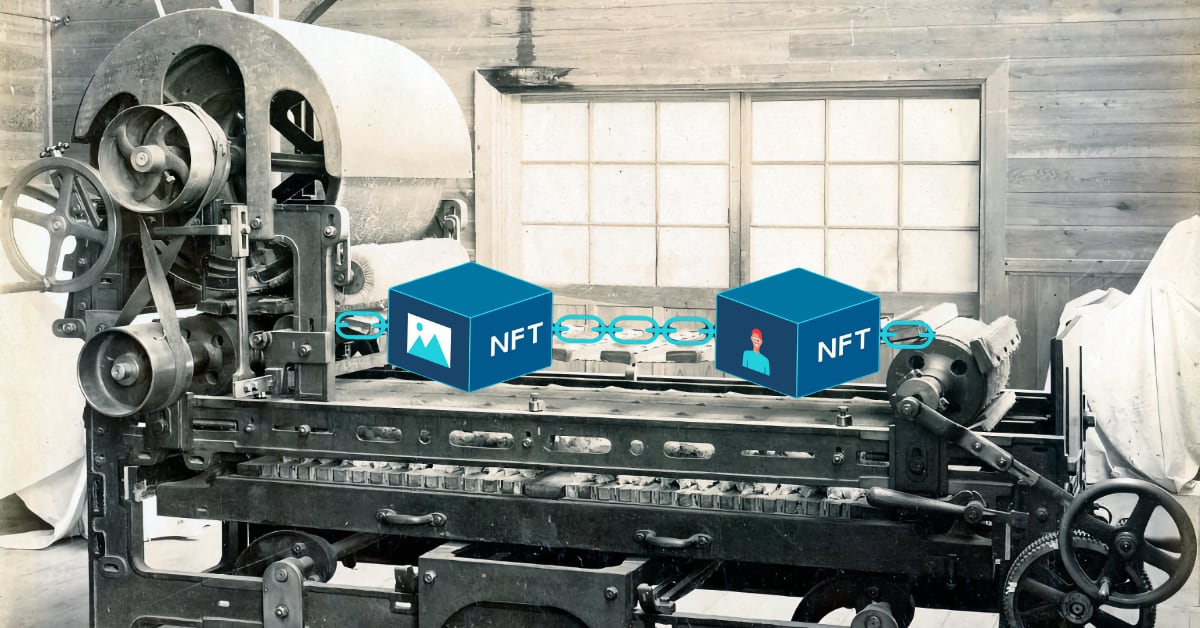By now, NFTs and their media coverage are well-hated by the average person (obviously not the average person in crypto)…
There’s been an overkill of NFT scams and people trying to make a quick buck on NFT and those who don’t understand the technology just perceive them as a new type of microtransaction.
Then they are those who have read a little more and know them as monkey pictures celebrities use or some type of shady tax schemes. But the majority of people, are not somewhere close to grasping the full potential of NFT technology yet… but you are here now and that will change after reading this post!
I’m personally at a point where I think it’s a technology with great potential, but that is being misused in a lot of places as outlined above. However, I am convinced that the underlying NFT technology will change how we do things in a disruptive way like the internet did and it will open doors to new and more fascinating technologies and intelligent systems.
NFT Technology
Most people who don’t understand how the NFT technology works keep limiting its use to just arts and collectibles. To them, NFT is a form of cryptocurrency with a piece of artwork slapped onto it. While this is one of the forms of NFT, it isn’t the only form and there is so much more.
Any NFT-asset that could be stored on the blockchain itself, adopting its properties, which in the case of a decentralized, immutable blockchain would be way superior to centralized repositories of paper.
Think about how many historical records and important documents like birth certificates, wills, and property deeds forever have been lost and how this can be avoided forever. This new NFT technology provides an opportunity to develop the world’s economy in ways that we could’ve never imagined before.
Now, in what other ways can the world utilize NFT technology? Let’s find out!
NFT Technologies currently being Used
There are extensive possible uses of the NFT technology. For this article, we’ve highlighted the latest innovative ways to use NFT technology that you probably didn’t know before.
1. Documentation
Documents are the easiest to forge, and thus authenticating them can be arduous. Fortunately, the NFT technology makes this issue a thing of the past. With this technology, you can verify diplomas, licenses, medical histories, birth certificates, and even passports. Academic recruiters and hiring managers can also screen and verify candidates’ educational credentials quickly using this system.
Certificates to prove ID or qualifications are something that everyone needs and are a pain to keep hold of and are easily lost. An NFT could be produced by the government or educational instituate that can be 100% verified without doubt of ownership or validity.
In short, the NFT technology eradicates the issue of fraud and makes verification all the easier. An example of a service that uses blockchain technology to verify academic profiles, histories, and credentials is BlockCerts. Even though this service is yet to use the NFT technology properly, they’ve been successfully experimenting a lot with BlockChain.
2. Gaming
The gaming industry is a highly potential arena for NFTs because it has already explored the theory of virtual worlds. In this sector, NFTs allows you to tokenize in-game items and easily transfer or exchange these items with peer-to-peer marketplaces. As a result, you can tokenize character abilities, features, tools, weapons, etc.
Decentraland is a splendid example of a game that uses blockchain technology to organize a digital marketplace. The gaming community wholly owns the game, and it gives players complete control over their virtual assets.
Other examples of blockchain-based games are Battle Pets and Axie Infinity. These games have tradable elements and are based on role-playing scenarios. Currently, more than 3 million people play Axie Infinity daily, which explains the company’s current value of almost 4 million dollars.
3. Ticketing
Fair ticketing is my favorite NFT use case. Based on a poll released by CNBC, 12% of online concert ticket buyers are victims of ticket scams and fraudulent sales. That’s where NFT technology comes in. It helps to drastically reduce these numbers by making it easy to trace the ticket owners, verify the authenticity of the tickets and transfer ownership through a secure and transparent channel.
NFTs also give companies the option to make their tickets non-transferable. This makes reselling a ticket impossible and reduces the risk of scalping.
GUTS is a ticketing platform impressively exploring blockchain technology in the sector. It already uses this technology to prevent fraudulent ticket selling. Another one that is leading the way is GET protocol.
NFT technology is not limited to concert tickets only and can also be used for other slips, receipts, and tokens. For instance, we can use it to hand out tickets to people on public transport. Ideally, traffic passes could have inbuilt NFT codes that would serve as unique means of identification for passengers.
Those codes would allow scanners on public transport to verify payments and hand out digital receipts. Additionally, they would also store every transaction record onto the NFT. That way, passengers would not dodge paying their fares and, at the same time, would have secured payment records.
We can also use the NFT technology to identify and penalize traffic offenders. Since the NFT code serves as a unique ID, scanners that support NFT tracking can easily identify offenders.
4. Dividend Programs
If you’re into investments, NFTs change how you view stock ownership in a company. Companies use the technology to confirm and authenticate stock ownership and pay the NFT holders dividends. This model applies to every revenue-generating asset, including bonds, mutual benefits, and insurance.
A real-life example is a person who purchased a digital Monaco racing track in the Formula One Delta Time game. Through this investment, the individual can receive a 5% dividend on the total earning of that particular track.
5. Supply Chain and Logistics
NFT can contribute to the logistics industry, and aid businesses evolve from where they currently are.
We can utilize NFTs to trace the items circulating the networks of supply chains using their time-stamped metadata. For every product that runs through these chains, the NFTs scan and adds new time-stamped metadata at every point in the exchange.
Maersk’s TradeLens System has set an excellent example of utilizing blockchain technology in logistics.
The only major problem in using NFT in logistics is that each stage of the supply chain has to use the same infrastructure that supports NFT. As a result, it might take a while to implement the NFT technology to accommodate the involvement of all the different players and global stakeholders.
6. Website Experience
Another mind-blowing way to utilize NFT technology is to improve users’ website experience.
Forbes utilizes NFTs through an unlocked protocol for an ad-free experience. They have connected their website with the Ethereum wallet for easy subscriptions. This allows users to purchase their membership NFT for an ad-free site.
Traditional paywall solutions often rely on card payments which are expensive and become a tool for fraud. On the other hand, the unlocked protocol allows website owners to choose and monitor what token their paywall accepts. They can also manage how many passes are acceptable and how long they last with just a few short lines of coding.
7. Automobiles
We cannot overlook the automobile industry when it comes to innovation using NFT technology. NFTs can be used to tokenize the profile and all other necessary information related to a car or any vehicle.
Take the Alfa Romeo Tonale SUV, for example. This car is the first to utilize the NFT tech and comes with its own NFT.
Mostly, cars have a service book where the car owners put down every detail relating to the vehicle, from any repairs or modifications to the car’s mileage. Car owners, potential buyers, and anyone looking for information on the car can also check websites like the DMV. However, the use of NFT makes it so that you don’t have to fill in or look for the car’s history under a massive pile of paperwork, as this information is already ingrained in the car.
The Toleno uses its NFT to record the history and profile of the car. This way, you don’t have to use a physical service or the DMV website. All a prospective buyer has to know is adequately provided by the car unto an NFT. Each vehicle has its own unique NFT, and the vehicle records whatever data it gets from its electronic system on the blockchain.
The idea is to provide car buyers with information that dealers or the OEM do not manage. It also assures them that the information has not been corrupted to charge more than the car’s worth.
NFTs can also instantly verify details of your car parts. This includes when and where a particular part was manufactured so that you can easily estimate replacements.
8. Finance
In Decentralised Finance (DeFi), NFTs provide ways to gain unique financial benefits. Devi’s value is connected to its constant and consistent use. Let’s check out JustLiquidity as an example. It allows users to ante a fragment of tokens in a pool for a limited duration. In simple words, it allows users to stake their NFTs. The users receive an NFT to access the next pool afterward. The NFTs act as entrance tickets and are destroyed once you participate in a new collection.
Another example is Bakery Swap’s NFT food combo, where stakeholders receive increased staking rewards. By contributing to BAKE, a stakeholder receives an NFT combo that provides different levels of staking power. Hence, individuals can sell these combos, bet on them, or use them for wagering.
The combination of NFTs with DeFi and gamification provides an exciting and engaging use case for Tokens.
9. Music Ownership
Generally, we believe that NFTs are tokens with an image or even a video linked to them. However, did you know that you can also tokenize an audio file? Or even create a blockchain based music collection generated by AI?
Like an art collectible token, you can also link songs and audio files to an NFT, but the number of unique use cases here is even more.
The biggest trouble for musicians is fairly getting a share in royalties. NFTs allow artists to remedy this problem by using blockchain-based streaming and royalty tracking.
Smaller music platforms have recorded significant success using NFT technology. For example, Rockie on the Binance Smart Chain gives independent musicians a platform to sell, stream their music and gain royalties. Their platform raised 40ETH for 50% royalties through their first NFT sale. The token standard used was ERC721, which could be used as a model for all streaming platforms. However, its success relies heavily on more major streaming services adopting it.
Presently, only small music projects have adopted this model, and they’re still unable to compete with streaming powerhouses like Youtube and Amazon. In fact, in 2017, Spotify’s acquisition of Media Chain did not yield any benefits.
Combining music with NFT is an excellent scenario for artists, but it would require the support and commitment of labels to work. This future might not be that far off as major artists like Grimes and Shawn Mendes have begun to dip their hands into the NFT pool.
10. Physical Assets
Sometimes, tracing a landlord or the owner of a particular piece of jewelry can be very difficult, but the NFT technology can provide a permanent solution. You can use NFTs to verify ownership of assets like houses, jewelry, or cars.
Like with other applications, NFTs can help prevent the occurrence of people reselling a piece of property they don’t own and have no right to sell. It can also digitize the ways we prove ownership. For example, in real estate, we typically deal with physical property dee
ds. Generally, we assume that whoever has the acts to a house is its actual owner, even though we’re not sure if the documents are credible. With the NFT technology, it would be easy to track, trace and verify the real estate owner.
In 2021, Shane Dulgeroff came up with an NFT to display property available for purchase in California. He also attached a piece of crypto art to the NFT. So whoever succeeded in closing a deal would ultimately gain the ownership of the property through the NFT.
Another company that is using NFTs within Real Estate is Lofty which is using NFTs for fractional real estate investing by registering each property to an LLC and that LLC to a divisible NFT which represents a % share of ownership. NFT holders then get distributed their % of the rent payments and can vote on property needs.
Once Real Estate will eventually skip the notary and city archives and are instead sold as NFTs on the Blockchain it would make life a whole lot easier. Expanding on that, think of how it will transform deeds and titles to property, land, and vehicles. Linking NFTs to physical assets is a design still in development but is one to look out for in the future.
11. Domain Names
Like crypto addresses, you can also have domain names on the blockchain. The crypto address is similar to an Instagram handle, with each name being unique to its users.
These domain names enable you to easily handle any cryptocurrency or NFT. One of the platforms offering this service is Ethereum Name Service. With an NFT domain name, you can send, receive, and store hundreds of cryptocurrencies and NFTs with one simple domain.
Want to check out how this works and like what I am doing with this blog? Feel free to check my personal domain name here or support me by sending crypto directly to that Fomo’s NFT address at thatfomoisreal.nft.
12. Medical Industry
NFTs can grant healthcare workers a new and effective means to digitize the medical profession. The NFT technology can have many uses here, including providing an efficient record-keeping mechanism, tracking the pharmaceutical supply chain, and accommodating intelligent contracts for payments.
While the healthcare industry is already into digital records, these records become longer and more complex with every patient visit. At times, they even become difficult to access. However, NFT can resolve this issue so that people can access their medical history with the touch of a finger while prioritizing privacy and data security.
Since any information uploaded to an NFT must be correctly verified, it ensures patients that their data is absolutely correct. Once the data is converted to a token, no one can change or falsify it. The core purpose here is to give patients control over their medical history and offer one-tier access to it.
Examples of healthcare platforms that already use blockchain to resolve the mounting pile of hospital records are Patientory and MediaBlock.
Other than keeping records, medical practitioners can use NFTs to track the supply route of medical products. The pharmaceutical industry maintains high standards of product safety and stability. NFTs can help monitor the supply chain, reducing delays and human error. It can also reduce cost, effort, and waste at certain points.
NFTs provide a source of combating medical counterfeits that cost more than two million in losses to healthcare. Companies like Chronicled and Modum are working towards an efficient healthcare logistics solution using blockchain tech.
13. Metaverse
This list would be incomplete without including the role of NFTs in creating the Metaverse. In the Metaverse, everyone interacts with other users through avatars, as long as you have access to an internet connection.
Because micro-economies are constantly developing on the Metaverse, NFTs offer a verifiable medium to prove ownership of virtual property. Smart contracts and blockchain technology guarantee the protection of ownership rights till the existence of NFTs.
With the aid of intelligent contracts, NFT owners may seek payments on future transfers or loan out their characters to gamers. These gamers will share the play-to-earn rewards and hand over the rest to NFT owners.
The possibilities on the Metaverse extend to more than just gaming. Using their avatar, a person can build virtual real estate, record virtual AI-generated videos and own several properties, including houses, shopping malls, and restaurants. Additionally, Metaverse users can order food via UberEats and purchase virtual products through OpenSea.
As BlockChain technology progresses, the MetaVerse will develop and unlock its full potential. The Metaverse, with the help of NFTs, will spread across more platforms, onboard more users, and build more digital communities.
NFT is Here to Stay
The current use of NFTs for just art is merely a passing phase that will evolve into something more. The potential for the NFT technology is far more significant than its current uses.
Even though we only provided you with thirteen potential sectors where NFT technologies will be used, the possibilities are truly endless. It paves the way for internal relations, business sectors, and even the legal industry.
The NFTs are already creating real solutions to real problems. Many companies are recognizing the potential of NFTs and inventing new ways to incorporate them into their products and services.
In case I missed an NFT technology, feel free to let me know in the comments below so I can do my research and possibly add it to this list. Hope to hear from you!



